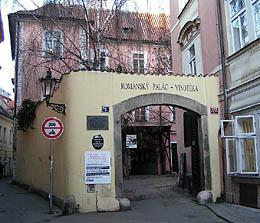
The House of the Lords of Kunštát has been renovated after four years
 |
"After years of neglect, we have returned the palace, which houses the best-preserved Romanesque secular architectural monument in Prague, to its original form and dignity that it deserves," Klega stated. This is the only building in the capital where Romanesque elements can be found even on the first floor. In other houses, they are only in the basement.
The ground floor retains the original Romanesque ashlar masonry, while in the basement are remnants of two fireplaces, Romanesque vaults, and impressions of original wooden formwork. Access to the cellars was through a single door that could be secured from the inside with a bolt. "It was some sort of last refuge space in case of danger," said architect Zdeněk Dragoun. At the end of the 12th century, the Old Town did not yet have fortifications, so Romanesque houses served as shelters.
The upper part of the house is built in Gothic style and adapted in the Renaissance style. "What is valuable about this object is the layering of individual styles from Renaissance, Baroque, Classicism to today's style," stated Michael Zachař from the Institute of Heritage Care. Tenants will live in apartments with original beam ceilings. They will walk on parquet floors of Viennese type, composed of squares arranged either flat or diagonally.
The apartments also reflect the contemporary era. People will have modern bathrooms and kitchen furnishings that certainly do not aim to look as if from past centuries. The architects also used glass blocks.
There are eight apartments on the floors of the house. According to Klega, tenants will be selected by the city hall in a competition for the highest initial rent. There should be publicly accessible spaces on the ground floor, such as a gallery with a wine shop. The selection process will decide this.
In addition to the lords from Kunštát and Poděbrady, other significant noble families such as the Hrzán family, the Šternberk family, or the Waldstein family also owned the house. Since the 1950s, the archaeological department of Prague's Institute of Heritage Care has used the house, which housed offices and storage spaces.
The English translation is powered by AI tool. Switch to Czech to view the original text source.
2 comments
add comment
Subject
Author
Date
Přístup pro veřejnost?
Marcel od Zvonu
16.08.07 03:28
Dům
MP
16.08.07 04:04
show all comments










